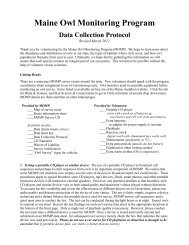Focus Species Forestry - Maine Audubon
Focus Species Forestry - Maine Audubon
Focus Species Forestry - Maine Audubon
Create successful ePaper yourself
Turn your PDF publications into a flip-book with our unique Google optimized e-Paper software.
American Marten<br />
Distribution: Alaska to Newfoundland, south to<br />
Nevada, New Mexico, northern Minnesota, northern<br />
New York, and northern <strong>Maine</strong><br />
<strong>Maine</strong> <strong>Focus</strong> Region: North<br />
Home Range: Average 1 sq. mi. for females, 2 sq.<br />
mi. for males (640-1,280 acres)<br />
Food: Primarily small mammals including voles,<br />
mice, red squirrels; also grouse, hare, bird eggs, fruits,<br />
berries, and nuts<br />
Special Habitat Needs: Extensive mature hardwood, mixed-wood, or conifer forests with abundant snags and<br />
downed trees and other structural features<br />
Management:<br />
Maintain an average of 7 marten habitat units (no less than 2) per township that are:<br />
• >1,250 acres, with<br />
• 75% of stands >40 ft. tall with basal area >80 sq. ft./acre, and<br />
• include at least one large, intact patch of 700-1,000 acres that meets the height and density<br />
requirements above.<br />
Maintain dead trees, logs, root mounds, and other structural features as denning sites and cover for small<br />
mammals that are the marten’s staple diet. See snag and cavity tree guidelines (Section 7).<br />
Use even-aged or uneven-aged management, as long as basal area, height, and snag/deadwood goals are<br />
met. Regeneration using a shelterwood-with-reserves system in conifer and mixed stands will promote<br />
softwood regeneration and prey, especially snowshoe hare, while maintaining canopy cover.<br />
Restrict access during trapping season.<br />
Comments: Commonly called the pine marten in <strong>Maine</strong>. Extensive research at the University of <strong>Maine</strong> suggests<br />
that management for marten will provide habitat used by most northern forest species, except those that require<br />
very young or late-successional forest conditions. Marten are easily trapped, so where road densities are high,<br />
access should be restricted during trapping season to enhance survival<br />
Habitat Use:<br />
Aspen-Birch<br />
Forest Ecosystems<br />
Northern<br />
Hardwoods Oak-Pine Hemlock Spruce-Fir<br />
N. White<br />
Cedar<br />
R S I M R S I M L R S I M L I M L R S I M L I M L<br />
Special-value<br />
Habitats<br />
Riparian/<br />
Wetland Vernal<br />
Forest Pool<br />
R Regeneration and seedlings Mx Mixed conifer-deciduous <strong>Focus</strong> habitat<br />
S Saplings and small poles U Understory present Other habitat<br />
I Intermediate-aged forest C Cavity tree or snag Little/no use<br />
M Mature forest<br />
L Late-successional forest<br />
References: Boone and Krohn 1998, Burt 1976, Chapin et al. 1998, DeGraaf and Yamasaki 2001, Fuller and<br />
Harrison 2000, Harrison 2004, Payer and Harrison 2003, Payer and Harrison 2000a, Payer and Harrison 2000b<br />
<strong>Focus</strong> <strong>Species</strong> <strong>Forestry</strong> 39



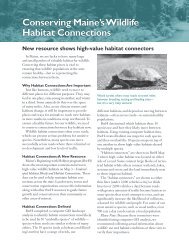
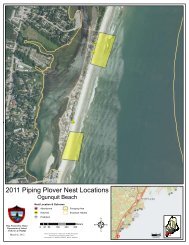
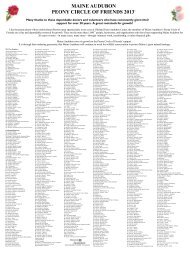
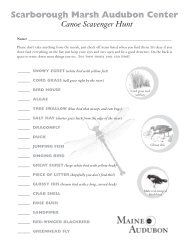

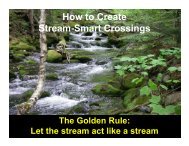
![2012 Loon Count Results [pdf] - Maine Audubon](https://img.yumpu.com/26228732/1/190x245/2012-loon-count-results-pdf-maine-audubon.jpg?quality=85)
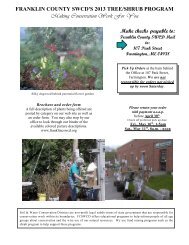
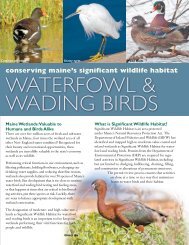
![Lake Fish of Maine (DIFW list) [pdf] - Maine Audubon](https://img.yumpu.com/23282964/1/190x245/lake-fish-of-maine-difw-list-pdf-maine-audubon.jpg?quality=85)
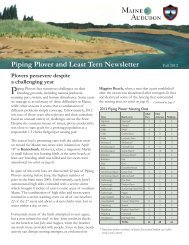

![The Maine Audubon Peony Circle of Friends 2012 [pdf]](https://img.yumpu.com/22707677/1/190x253/the-maine-audubon-peony-circle-of-friends-2012-pdf.jpg?quality=85)
